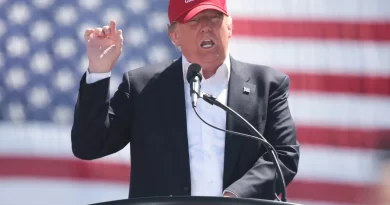We research rumors. Here’s how the right’s election denial machine has evolved.

Since 2020, many voters have been increasingly primed to see elections as unfair and potentially rigged. Lasting election denialism has fanned mistrust in election administration, particularly among Republicans. After Donald Trump questioned or rejected the validity of results of both 2016 and 2020 contests, it could be especially difficult for his supporters to accept a potential loss in such a tight race in 2024.
As researchers of rumors and rumoring, we study how people make sense of what’s going on in highly uncertain scenarios like elections. In the coming days, we expect thousands of rumors to circulate on (and off) social media. Though some may be built around kernels of fact, misleading rumors distort the truth and context, obscure solutions, and fuel conspiracy theories of an intentional voter fraud scheme.
Fledgling versions of this infrastructure were present in the 2020 and 2022 elections.
What is striking about the 2024 election is not the prevalence of rumors, but the maturation of an “evidence generation infrastructure,” consisting of political organizations, partisan media, social media, technological platforms, and a growing legal apparatus. The collaboration is loosely organized, but also strategic, and works both to promote “proof” of fraud and motivate political and legal action to contest the results. Fledgling versions of this infrastructure were present in the 2020 and 2022 elections — but now the machinery is well-oiled and ready for action. It operates through three C’s: convince the public of election fraud, collect perceived “evidence” of alleged fraud and contest election processes and results using this “evidence.”
Last week, we saw the “three C’s” at work. On Tuesday, Pennsylvanians faced long lines at the Bucks County election office to register for a mail-in ballot before the deadline that afternoon — inciting rumors online.
Law enforcement had told people in the queue that they were closing the lines down early — an action that goes against the standard protocol of letting those in line before a deadline stay in line to vote. Aspiring voters quickly posted videos of their arguments with police and poll watchers. Political actors and influencers packaged these videos and promoted them, misleadingly, as evidence of a larger, nefarious effort by Democrats to rig the election. They urged those in line to submit reports to election integrity groups. To counter these claims, a few voices on the left baselessly accused the right of hiring actors to play police officers.
Ultimately, Trump’s campaign filed and won a lawsuit that extended the deadline for those in line. Influencers celebrated the win and the work of watchdogs, who posted the videos and made them go viral.
Like many voting-related rumors, this one was based upon a real issue, and one that was eventually remedied. But the misleading narrative that closing the lines down was an intentional effort to suppress Republican votes as part of a larger conspiracy? That unfounded story is likely to persist.
At their best, election integrity observers can serve to quickly surface real issues. At their worst, they can incite misleading or baseless rumors that can increase mistrust in election procedures. Self-described election integrity organizations, many of which are sympathetic to Trump, have developed new tools and repurposed existing infrastructure to encourage the capture and digital sharing of “evidence” of perceived election fraud — evidence often intentionally mischaracterized to peddle a narrative that the election is rigged.
Starting in 2020, political actors built an infrastructure to recruit poll watchers, primed them to suspect mass voter fraud and encouraged them to report even routine procedures and minor issues as conspiracies. We’ve seen previously that this reporting sparks misleading claims that can spread rapidly online rapidly and support lawsuits, affidavits, and other actions that spiral into further rumoring. Even when individual rumors fade or are debunked, the overall narrative of a rigged election lives on.
The lasting election denialism sown by this “evidence generation infrastructure” in 2020 altered election administration, enfranchisement, and election trust — often for the worse. After four years of development, this infrastructure is already exacerbating the cycle of convincing the public of voter fraud, encouraging them to collect evidence, and then mobilizing political and legal action to contest procedures and results. The Trump campaign and Republican partisans have already begun filing lawsuits claiming voter fraud in swing states, many of which are “zombie lawsuits” likely less intended to remedy a specific problem than to cast doubt on election outcomes more generally.
Partisan operatives have already succeeded in convincing the public that the election is fraudulent.
Given this robust infrastructure and the Trump campaign’s considerable resources for its legal funds and “election integrity” efforts, we have already seen hundreds of pre-election lawsuits and we expect to see many more. In key races, candidates or political groups who already subscribe to the “rigged election” theories may begin organizing protests at vote-counting centers or even attempt to overturn the results.
Tensions are running high as we inch closer to Election Day. Depending upon the outcomes and margins of key races, they could get worse. Partisan operatives have already succeeded in convincing the public that the election is fraudulent. We will see these operatives collect and spread misleading or untrue “evidence” of rigging. And, using this election denial machine, some MAGA partisans are primed and ready to contest outcomes. Let us hope they don’t go so far as to contest democracy itself.

